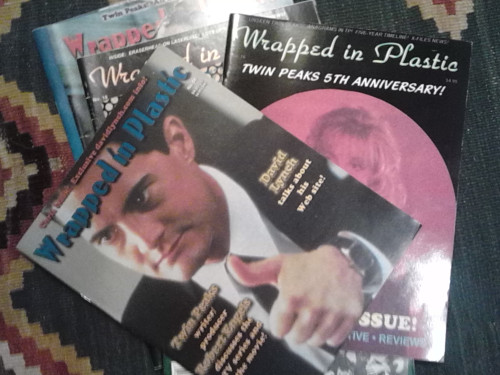
Twin Peaks (1990-91), the brainchild of creators Mark Frost and David Lynch, has, in the last decade, risen above cult status. In part this is due to Lynch’s Oscar nominated Mulholland Drive (2001), and part to the various DVD releases of the show and its streaming on Netflix. Indeed, almost all of the success of the show, be it when the show originally aired or today, is attributed to David Lynch, and occasionally Mark Frost. But in the interim, between Twin Peaks: Fire Walk With Me (1992) and the release of Twin Peaks: The Return, it was the fanzine Wrapped In Plastic (1993-2005) that nurtured interest, merchandising, and critical debate around the show and its creator’s other projects from Lost Highway (1997) to Storyville (1992).
Phenomenon like the Twin Peaks resuscitation is rare in film and television. Perhaps the greatest example of a fan motivated revival is the franchise Star Trek, whose initial six features were the result of a decade long campaign by fans to bring the original television series back. It’s too early to tell whether Twin Peaks will spark the sort of fan base and coinciding franchise that Star Trek did, but it is undeniable that the responsibility for any “rediscovery” of Twin Peaks by the public is due to Wrapped In Plastic and its readers.
Wrapped In Plastic was not an iconoclast in its genre, nor was it that consistent in its writing. It did, however, fill an unlikely niche by bringing Twin Peaks to its fans in print for 75 issues. Typically the format was quite standard for a fanzine; a cover story, an essay or two, some brief reviews on projects by Twin Peaks’ cast and crew, and then the letters section. Wrapped In Plastic also covered Chris Carter’s X-Files, linking it thematically and aesthetically to Twin Peaks a number of times. By incorporating articles and occasional cover stories on X-Files the fanzine was able to broaden its fan-base. It is essential to put into context the function of the fanzine at the turn of the 21st century when such periodicals were primarily found in the then obscure comic shop and therefore had to compete with fanzines for Star Trek, Star Wars, Buffy The Vampire Slayer, Vampirella, Battlestar Galactica, James Bond, etc. The already insular nature of those frequenting such shops provided a tight sense of community to the Wrapped In Plastic reader, prompting events designed to mirror Star Trek and comic book conventions but aimed at Twin Peaks.
This end of the Twin Peaks culture, its true “cult”, has not yet broken onto the social media platforms of the show’s newest fans. In fact it is hard to get a handle on its function and very nature outside of the back issues of Wrapped In Plastic. This gets to the very heart of “cult followings” in the age of cyber-space. Fanzines like Wrapped In Plastic have been replaced by blogs, much like this one. But these blogs do not come with the built in distribution direct to a niche audience that a printed fanzine comes with. Thus communities like those built up by Wrapped In Plastic are slow to transition to social media, often suffocated by legions of new fans posting and blogging about the same subject. This also furthers the novelty sensibility of a conference or festival held by fans beyond the reaches of the internet. Consider the anarchist free-for-all of Twin Peaks blogs on tumblr in contrast to Radiohead and Sonic Youth blogs which function with a clear cohesion and sense of community.
There is simply something intrinsically communal about picking up a fanzine, an immediate sense of belonging, reassuring one’s self that there are other people in the world with like-minded interests. The power of print, in this fashion in particular, is largely responsible for the hardcore punk scene of the eighties that sparked bands such as The Minutemen, The Replacements, Beat Happening, and Sonic Youth. Personally, it was this sense of belonging that I felt when I bought my first issue of Wrapped In Plastic from Steve’s Comic Relief in 2001. And, for me at least, that notion of Twin Peaks as a wider community of fans is absent from blogs. So the benefits of Wrapped In Plastic have been two fold. Firstly it provided a communal platform for fans and, secondly, breathed new life and interest into the landmark television show.
